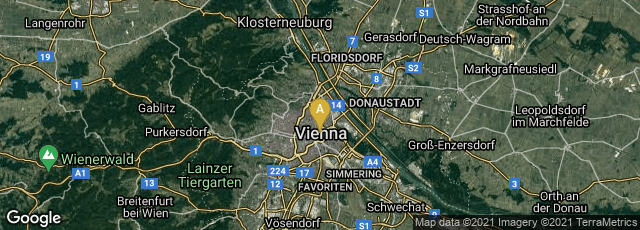

A: Innere Stadt, Wien, Wien, Austria
In 1769 Hungarian author and inventor Wolfgang von Kempelen (Johann Wolfgang Ritter von Kempelen de Pázmánd; Hungarian: Kempelen Farkas) built his chess-playing Turk, an automaton that purported to play chess. Although the machine displayed an elaborate gear mechanism, its cabinet actually concealed a man controlling the moves of the machine.
Von Kempelen's Turk became a commercial sensation, deceiving a very large number of people. It became the most famous, or the most notorious, automaton in history. It also must have been kind of an open secret within the professional chess community because over the years numerous chess masters were hired so that The Turk could challenge all comers with its chess skills. With a skilled concealed operator the Turk won most of the games played during its demonstrations around Europe and the Americas for nearly 84 years, playing and defeating many challengers including Napoleon Bonaparte and Benjamin Franklin. Although many had suspected the hidden human operator, the hoax was first revealed in scientific detail by the English engineer Robert Willis in his illustrated pamphlet, An Attempt to Analyse the Automaton Chess Player of Mr. de Kempelen. With an Easy Method of Imitating the Movements of the Celebrated Figure. . . (London, 1821).
The operator or operators working within the mechanism who played chess during Kempelen's original tour remain a mystery; however after the engineer Johann Nepomuk Mälzel purchased the device in 1804, and exhibited it first in Europe and in 1826 in America, the chess masters who secretly operated it included Johann Allgaier, Hyacinthe Henri Boncourt, Aaron Alexandre, William Lewis, Jacques Mouret, and William Schlumberger. In 1818, for a short time while Boncourt was the operator of the Turk, he caught the flu and his chess performance was rather poor, and he could not control his coughing which could be heard by spectators, creating a certain embarrassment to Mälzel who owned the machine. For this reason Mälzel added some noisy gears to the Turk, which had no other purpose than to cover any noise that might come from the operator.
Even though the machine intelligence exhibited by the Turk was an illusion, von Kempelen's automaton was much later viewed as an analog to efforts in computer chess and artificial intelligence.